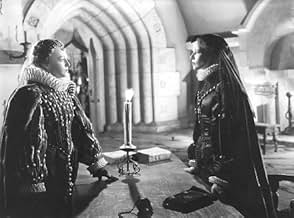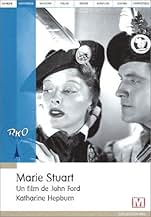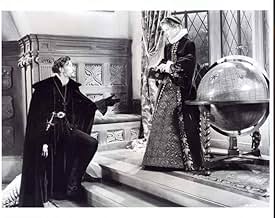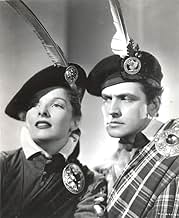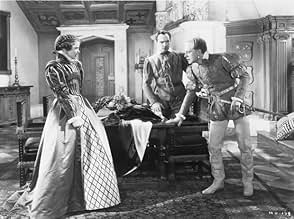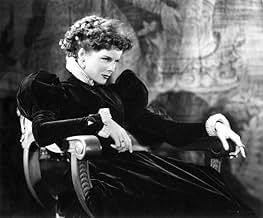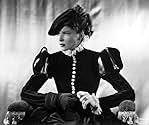AVALIAÇÃO DA IMDb
6,3/10
2,9 mil
SUA AVALIAÇÃO
Adicionar um enredo no seu idiomaThe recently widowed Mary Stuart returns to Scotland to reclaim her throne but is opposed by her half-brother and her own Scottish lords.The recently widowed Mary Stuart returns to Scotland to reclaim her throne but is opposed by her half-brother and her own Scottish lords.The recently widowed Mary Stuart returns to Scotland to reclaim her throne but is opposed by her half-brother and her own Scottish lords.
- Direção
- Roteiristas
- Artistas
- Prêmios
- 3 vitórias e 1 indicação no total
- Direção
- Roteiristas
- Elenco e equipe completos
- Produção, bilheteria e muito mais no IMDbPro
Avaliações em destaque
Mary of Scotland is not based on the exact historical record, but on Maxwell Anderson's play. However Anderson was trying to dramatize the difference between Elizabeth Tudor and Mary Stuart. Elizabeth was first and foremost a queen who put her passions on hold when it was a choice between them and the country she governed. Mary Stuart was totally incapable of doing that.
Interesting that Katharine Hepburn played Mary. Hepburn who was probably the liberated woman of the 20th century would have been a natural to play Queen Elizabeth. Too bad in fact she didn't in her career. But she does fine her as Mary. Florence Eldridge plays a cold, calculating Elizabeth. Fredric March as Lord Bothwell is not the hero he's shone to be here.
One thing about Scotland in the 16th century. The kingdom had the unbelievable rotten luck of having a whole succession of minority rulers with regencies for a couple hundred years. The nobles who are depicted here are quite used to having their own way. And when Mary abdicated the throne it went to still another regency when her infant son James became king.
Ian Keith's part as Hepburn's illegitimate half brother the Earl of Moray is an interesting one. In history, I've always thought of him as the real hero. He gave Mary sound advice which had she taken, she would have died on the throne of Scotland.
Vanessa Redgrave's later film shows how the exiled Mary Stuart got tricked into a conspiracy to bring Elizabeth down. I wish that had been done here. She was essentially AbScammed.
Elizabeth and Mary never met in real life, but for dramatic purposes it had to happen here.
It's a good film, not one of the best for any of the principals in the cast or for John Ford. Still it's an interesting piece of cinema although some knowledge of Scottish history might help.
Interesting that Katharine Hepburn played Mary. Hepburn who was probably the liberated woman of the 20th century would have been a natural to play Queen Elizabeth. Too bad in fact she didn't in her career. But she does fine her as Mary. Florence Eldridge plays a cold, calculating Elizabeth. Fredric March as Lord Bothwell is not the hero he's shone to be here.
One thing about Scotland in the 16th century. The kingdom had the unbelievable rotten luck of having a whole succession of minority rulers with regencies for a couple hundred years. The nobles who are depicted here are quite used to having their own way. And when Mary abdicated the throne it went to still another regency when her infant son James became king.
Ian Keith's part as Hepburn's illegitimate half brother the Earl of Moray is an interesting one. In history, I've always thought of him as the real hero. He gave Mary sound advice which had she taken, she would have died on the throne of Scotland.
Vanessa Redgrave's later film shows how the exiled Mary Stuart got tricked into a conspiracy to bring Elizabeth down. I wish that had been done here. She was essentially AbScammed.
Elizabeth and Mary never met in real life, but for dramatic purposes it had to happen here.
It's a good film, not one of the best for any of the principals in the cast or for John Ford. Still it's an interesting piece of cinema although some knowledge of Scottish history might help.
Brooks Atkinson was a first rate drama critic for the New York Times. He had blind spots. He over enthused on the career of Maxwell Anderson. Anderson wrote some good plays such as "Winterset", but Anderson was enthusiastic of Anderson's pompous attempts to do dramas in blank verse: "Mary Of Scotland", "Elizabeth The Queen", and "Anne Of The Thousand Days".
The problem with these plays is, even if they get the history right they are too stiff. Compare the conclusion of "Elizabeth The Queen" to "A Man For All Seasons". Yes, the loneliness of the elderly Elizabeth is shown as Essex goes to his doom - but in reality Elizabeth knew there were other young men to replace her dangerous, ambitious lover. In "All Seasons" the tragedy of a rotten system crushing the life of a decent, thoughtful man like Thomas More is far more powerful as it's stark tragedy is silently brought to us.
That said, the first of the three Tudor tragedies to be filmed was "Mary Of Scotland". It is above average because it is starring Katherine Hepburn (a distant relative of Mary's third husband the Earl of Bothwell) and Frederic March, and directed wholly or partially by John Ford. It suffers from being black and white, except for one moment of sheer unexpected terror: when Mary sees the Scots nobles who oppose her they are photographed in such light and darkness to look like ogres in a nightmare.
The film follows the reign of Mary from 1560 to her execution in 1587. Most Americans do not understand the great difficulties that Mary (and Elizabeth) both faced in their parallel reigns. While England and Scotland allowed for female monarchs, women were not considered good material for rulers. They were considered governed by their emotions more than by their brains. Those women who ruled well were usually married to capable partners (Isabella of Castille and Ferdinand of Aragon of Spain). More frequently they were dismissed as misfits, like Isabella and Ferdinand's daughter Juana the Mad).
Mary had other problems. From 1400 to 1560 the nobles of Scotland got a great boon. Scotland had a series of minors who grew up to be king, married, and then died before they could cement their monarchic views on the government. The nobles cemented their local powers at the expense of a weak central authority.
Mary had been Queen of France, married to Francis II who ruled for a two year period (1559 - 1560). As Mary was the niece of the Duc De Guise, the king's power-hungry mother Catherine De Medici hated her. When Francis died suddenly, Catherine encouraged Mary to return to rule her own country. Surprised Mary did so, not realizing that she was unprepared to start ruling. She was a Catholic, and she really needed some time to understand the need to compromise and take advice from Protestants. She never did understand this.
Her foes hated her and were fully supported by Elizabeth, who never could see that an attempt to join forces with her cousin might pay back great dividends. But then Mary was ambitious - she wanted to be Queen of England as well as Scotland. Her Catholic supporters felt she was legitimate Queen of England (as Henry VIII had briefly disowned Elizabeth as a bastard when he executed her mother Anne). So the peaceful resolution of their differences was almost impossible.
Elizabeth had only to watch from the sidelines, with only an occasional move on her own part, to see Mary wreck her own position. She encouraged a marriage between another cousin/potential heir Lord Henry Darnley to Mary (Mary almost chose Elizabeth's lover Robert Dudley!). The marriage was a disaster, as Darnley was an ambitious fool and vicious scoundrel. But it cemented a Scottish succession to the British throne from two Tudor heirs instead of one.
Hepburn portrays Mary as a brave woman desperately seeking a way out of the difficult situation she has inherited, especially tied to Darnley by marriage and facing the ghouls who are John Knox (Moroni Olsen) and the Scottish nobles - led by her jealous half brother the Earl of Moray (Ian Keith). Her only allies are the independent Earl of Bothwell (March) and her secretary Rizzio (John Carridine). The murder of the latter (implicating Darnley) is the first step to her loss of the throne, and to the death of her husband. We know today that Kirk'a'Field house was blown up by Bothwell, but to this day we don't know if Mary was implicated. It remains one of the big mysteries of the 16th Century.
Historically Bothwell was no prince, but ambitious in his own right - he killed Darnley in order to marry Mary, and guide her to rule both Scotland and England. But March plays him as a man deeply in love with his Queen, and this enhances the story's tragedy - especially as Bothwell died in exile insane. The reason for this was his ship was captured by a Danish warship. Bothwell was guilty of a rape in Denmark, and was imprisoned. His punishment (which led to his madness) was to stand chained to a stone pillar that was half his height.
The last ten minutes glosses over the road that led Mary to the block in England - her support of a plot by one Anthony Babbington to kill Elizabeth and let Mary take the throne. Elizabeth's spy-master Sir Francis Walsingham sprung this trap - though Elizabeth did not reject the result. Elizabeth allowed a functionary to be blamed for falsely getting her to sign the death warrant - but all she did was briefly imprison the man. Unlike her movie representative (Florence Eldritch) she never met Mary.
A good film - but it is too gentle on Mary's failings, and not deep enough to explain what is going on in the background.
The problem with these plays is, even if they get the history right they are too stiff. Compare the conclusion of "Elizabeth The Queen" to "A Man For All Seasons". Yes, the loneliness of the elderly Elizabeth is shown as Essex goes to his doom - but in reality Elizabeth knew there were other young men to replace her dangerous, ambitious lover. In "All Seasons" the tragedy of a rotten system crushing the life of a decent, thoughtful man like Thomas More is far more powerful as it's stark tragedy is silently brought to us.
That said, the first of the three Tudor tragedies to be filmed was "Mary Of Scotland". It is above average because it is starring Katherine Hepburn (a distant relative of Mary's third husband the Earl of Bothwell) and Frederic March, and directed wholly or partially by John Ford. It suffers from being black and white, except for one moment of sheer unexpected terror: when Mary sees the Scots nobles who oppose her they are photographed in such light and darkness to look like ogres in a nightmare.
The film follows the reign of Mary from 1560 to her execution in 1587. Most Americans do not understand the great difficulties that Mary (and Elizabeth) both faced in their parallel reigns. While England and Scotland allowed for female monarchs, women were not considered good material for rulers. They were considered governed by their emotions more than by their brains. Those women who ruled well were usually married to capable partners (Isabella of Castille and Ferdinand of Aragon of Spain). More frequently they were dismissed as misfits, like Isabella and Ferdinand's daughter Juana the Mad).
Mary had other problems. From 1400 to 1560 the nobles of Scotland got a great boon. Scotland had a series of minors who grew up to be king, married, and then died before they could cement their monarchic views on the government. The nobles cemented their local powers at the expense of a weak central authority.
Mary had been Queen of France, married to Francis II who ruled for a two year period (1559 - 1560). As Mary was the niece of the Duc De Guise, the king's power-hungry mother Catherine De Medici hated her. When Francis died suddenly, Catherine encouraged Mary to return to rule her own country. Surprised Mary did so, not realizing that she was unprepared to start ruling. She was a Catholic, and she really needed some time to understand the need to compromise and take advice from Protestants. She never did understand this.
Her foes hated her and were fully supported by Elizabeth, who never could see that an attempt to join forces with her cousin might pay back great dividends. But then Mary was ambitious - she wanted to be Queen of England as well as Scotland. Her Catholic supporters felt she was legitimate Queen of England (as Henry VIII had briefly disowned Elizabeth as a bastard when he executed her mother Anne). So the peaceful resolution of their differences was almost impossible.
Elizabeth had only to watch from the sidelines, with only an occasional move on her own part, to see Mary wreck her own position. She encouraged a marriage between another cousin/potential heir Lord Henry Darnley to Mary (Mary almost chose Elizabeth's lover Robert Dudley!). The marriage was a disaster, as Darnley was an ambitious fool and vicious scoundrel. But it cemented a Scottish succession to the British throne from two Tudor heirs instead of one.
Hepburn portrays Mary as a brave woman desperately seeking a way out of the difficult situation she has inherited, especially tied to Darnley by marriage and facing the ghouls who are John Knox (Moroni Olsen) and the Scottish nobles - led by her jealous half brother the Earl of Moray (Ian Keith). Her only allies are the independent Earl of Bothwell (March) and her secretary Rizzio (John Carridine). The murder of the latter (implicating Darnley) is the first step to her loss of the throne, and to the death of her husband. We know today that Kirk'a'Field house was blown up by Bothwell, but to this day we don't know if Mary was implicated. It remains one of the big mysteries of the 16th Century.
Historically Bothwell was no prince, but ambitious in his own right - he killed Darnley in order to marry Mary, and guide her to rule both Scotland and England. But March plays him as a man deeply in love with his Queen, and this enhances the story's tragedy - especially as Bothwell died in exile insane. The reason for this was his ship was captured by a Danish warship. Bothwell was guilty of a rape in Denmark, and was imprisoned. His punishment (which led to his madness) was to stand chained to a stone pillar that was half his height.
The last ten minutes glosses over the road that led Mary to the block in England - her support of a plot by one Anthony Babbington to kill Elizabeth and let Mary take the throne. Elizabeth's spy-master Sir Francis Walsingham sprung this trap - though Elizabeth did not reject the result. Elizabeth allowed a functionary to be blamed for falsely getting her to sign the death warrant - but all she did was briefly imprison the man. Unlike her movie representative (Florence Eldritch) she never met Mary.
A good film - but it is too gentle on Mary's failings, and not deep enough to explain what is going on in the background.
Mary of Scotland (1935)
** 1/2 (out of 4)
Historical drama from RKO about the rivalry between Mary of Scots (Katharine Hepburn) and her cousin Elizabeth I (Florence Eldridge). The film follows Mary's fight for justice from 1560 to 1587 and includes her third marriage to Bothwell (Fredric March). This film was a notorious flop when it was originally released and it had a large part in Hepburn being called box office poison. Seeing the film today it's rather amazing to see how good the film actually looks considering RKO was usually just popping out very low-budget films. There were certainly a few exceptions and this here is one of them and I'm sure many will be shocked to see how much actually went into this film. The amazing sets and costumes are one of the biggest selling points to the movie. Ford knows how to make things appear epic and he does that here with these amazing sets that make you feel as if you're at the actual locations. Many times these sets are obviously on some lot but you never get that feeling here. The costumes are another major plus as they help bring a realistic nature to the film. I'm not sure what the actual budget was on the film but it really does look just as expensive as many of de Mille's epics. Another reason the film is worth viewing is the performance by Hepburn. As a devoted atheist she really does a nice job in the role of a Catholic and her religious scenes are quite moving as she's certainly giving it her all. She's very believable in the part as you can tell she's strong enough to lead all the battles that Mary had to. That strong nature of the actress clearly shows up on the screen. March is also very good in his role, although the film could have used much more of him. I was a little Luke warm on Eldridge but after a while she started to grow on me. The supporting cast includes Douglas Walton, Frieda Inescourt, Donald Crisp and John Carradine. Carradine plays the servant Rizzo and does a pretty good job with it. We also get to hear him sing a couple songs, which I'm not sure how many times he had the chance of doing that in his long career. The biggest problem with the movie is that the story is at times hard to follow as it appears like the screenplay wasn't totally sure where they wanted to take all of the events. I think at times the story just seemed to float all over the place.
** 1/2 (out of 4)
Historical drama from RKO about the rivalry between Mary of Scots (Katharine Hepburn) and her cousin Elizabeth I (Florence Eldridge). The film follows Mary's fight for justice from 1560 to 1587 and includes her third marriage to Bothwell (Fredric March). This film was a notorious flop when it was originally released and it had a large part in Hepburn being called box office poison. Seeing the film today it's rather amazing to see how good the film actually looks considering RKO was usually just popping out very low-budget films. There were certainly a few exceptions and this here is one of them and I'm sure many will be shocked to see how much actually went into this film. The amazing sets and costumes are one of the biggest selling points to the movie. Ford knows how to make things appear epic and he does that here with these amazing sets that make you feel as if you're at the actual locations. Many times these sets are obviously on some lot but you never get that feeling here. The costumes are another major plus as they help bring a realistic nature to the film. I'm not sure what the actual budget was on the film but it really does look just as expensive as many of de Mille's epics. Another reason the film is worth viewing is the performance by Hepburn. As a devoted atheist she really does a nice job in the role of a Catholic and her religious scenes are quite moving as she's certainly giving it her all. She's very believable in the part as you can tell she's strong enough to lead all the battles that Mary had to. That strong nature of the actress clearly shows up on the screen. March is also very good in his role, although the film could have used much more of him. I was a little Luke warm on Eldridge but after a while she started to grow on me. The supporting cast includes Douglas Walton, Frieda Inescourt, Donald Crisp and John Carradine. Carradine plays the servant Rizzo and does a pretty good job with it. We also get to hear him sing a couple songs, which I'm not sure how many times he had the chance of doing that in his long career. The biggest problem with the movie is that the story is at times hard to follow as it appears like the screenplay wasn't totally sure where they wanted to take all of the events. I think at times the story just seemed to float all over the place.
There was something of a fad for Tudor-period dramas in the late 1930s, although Mary of Scotland is something of an overlooked picture in the careers of Katherine Hepburn and John Ford. The star and director went on to have an on-off love affair, although this was the only occasion on which they worked together.
Mary of Scotland has the look that is typical of Ford's RKO features. It's often forgotten that Ford was a director who liked to work with space, shape and light, usually manifested in a sharp contrast between the indoor and outdoor worlds. Here the contrast is between the palace of Elizabeth – light, open and filled of straight lines and symmetry – and the castle of Mary – small, shadowy and made of rough curves. At first glance this seems to imply that the Scottish setting is grimmer and more confined, but for Ford these cosy spaces with layers of shadows were also about honesty and simplicity – see for example the compositions he makes in The Informer or The Fugitive. Those two pictures were also made at RKO, and their expressive look is testament to the fact that although the studio might not have had much money it did have a strong and open-minded production design team, something Ford took advantage of when he could.
By this point, few Ford films would be complete without the sing-song scene, and there is an especially fine example in Mary of Scotland. Ford never made an out-and-out musical in his career, but the way he uses singing as an emotional backdrop is remarkable. Here, the song sung by the peasants as they march into the castle begins as a simple yet effective expository device – demonstrating where the people's loyalties lie – but then the scene moves onto another level. Ford isolates one singer, then cuts to a rare close-up of Hepburn. The beauty of the music provides a backdrop to her emoting. It is in such moments that Ford's direction is at its strongest.
This was perhaps an important breakthrough role for Hepburn, whose parts until now had mostly been as teenagers or young women. This is her first real adult role and she handles it well, albeit with one or two touches of uncertainty when she is required to act "queenly". She does however manage the task of humanising the queen, more so than the screenplay would seem to allow. Unfortunately her leading man, the normally excellent Fredric March, is rather bland here. It's a real treat though to see John Carradine in a role where he really gets to show his more sensitive side. Because of his looks, not to mention his creepy voice, the character actor generally landed villainous roles, but he was actually at his best playing good guys.
One oft-repeated story regarding this production – although it varies a little depending on who's telling it, so pinches of salt at the ready – is that Hepburn and Ford disagreed over the necessity of Mary and Bothwell's final scene together on the tower top. Ford thought it a pointless bit of soppiness, Hepburn said it was the most important scene in the script. Eventually a flippant Ford challenged Hepburn to direct it herself, which she did. The scene stands out because Hepburn actually shoots it with some romantic tenderness – something Ford hardly ever did – with lengthy close-ups and rhyming angles. You can see why Ford didn't like it; he tended to downplay the love themes in his pictures, and on top of that the scene is rather heavy on dialogue. Hepburn was right though – without this scene the romance between Mary and Bothwell would be little more than a subplot, and without the romance the film wouldn't work. Audiences would find it hard to empathise with a queen clinging onto her throne, but easy to sympathise with a woman separated from the man she loves.
Mary of Scotland was not really Ford's cup of tea, and it was his rather cavalier approach to interpreting a screenplay that spoiled a fair few of his pictures (even though it won him the admiration of the auteurists). This picture is only saved by his use of music, the proficiency of the RKO crew and of course the good judgement of Katherine Hepburn. Nevertheless, I can't help but love Ford's laid-back realism. In one scene, we see a dog barking crazily at men entering a room; in another a moth flutters about John Knox's head. How many other directors of that era would have kept those takes?
Mary of Scotland has the look that is typical of Ford's RKO features. It's often forgotten that Ford was a director who liked to work with space, shape and light, usually manifested in a sharp contrast between the indoor and outdoor worlds. Here the contrast is between the palace of Elizabeth – light, open and filled of straight lines and symmetry – and the castle of Mary – small, shadowy and made of rough curves. At first glance this seems to imply that the Scottish setting is grimmer and more confined, but for Ford these cosy spaces with layers of shadows were also about honesty and simplicity – see for example the compositions he makes in The Informer or The Fugitive. Those two pictures were also made at RKO, and their expressive look is testament to the fact that although the studio might not have had much money it did have a strong and open-minded production design team, something Ford took advantage of when he could.
By this point, few Ford films would be complete without the sing-song scene, and there is an especially fine example in Mary of Scotland. Ford never made an out-and-out musical in his career, but the way he uses singing as an emotional backdrop is remarkable. Here, the song sung by the peasants as they march into the castle begins as a simple yet effective expository device – demonstrating where the people's loyalties lie – but then the scene moves onto another level. Ford isolates one singer, then cuts to a rare close-up of Hepburn. The beauty of the music provides a backdrop to her emoting. It is in such moments that Ford's direction is at its strongest.
This was perhaps an important breakthrough role for Hepburn, whose parts until now had mostly been as teenagers or young women. This is her first real adult role and she handles it well, albeit with one or two touches of uncertainty when she is required to act "queenly". She does however manage the task of humanising the queen, more so than the screenplay would seem to allow. Unfortunately her leading man, the normally excellent Fredric March, is rather bland here. It's a real treat though to see John Carradine in a role where he really gets to show his more sensitive side. Because of his looks, not to mention his creepy voice, the character actor generally landed villainous roles, but he was actually at his best playing good guys.
One oft-repeated story regarding this production – although it varies a little depending on who's telling it, so pinches of salt at the ready – is that Hepburn and Ford disagreed over the necessity of Mary and Bothwell's final scene together on the tower top. Ford thought it a pointless bit of soppiness, Hepburn said it was the most important scene in the script. Eventually a flippant Ford challenged Hepburn to direct it herself, which she did. The scene stands out because Hepburn actually shoots it with some romantic tenderness – something Ford hardly ever did – with lengthy close-ups and rhyming angles. You can see why Ford didn't like it; he tended to downplay the love themes in his pictures, and on top of that the scene is rather heavy on dialogue. Hepburn was right though – without this scene the romance between Mary and Bothwell would be little more than a subplot, and without the romance the film wouldn't work. Audiences would find it hard to empathise with a queen clinging onto her throne, but easy to sympathise with a woman separated from the man she loves.
Mary of Scotland was not really Ford's cup of tea, and it was his rather cavalier approach to interpreting a screenplay that spoiled a fair few of his pictures (even though it won him the admiration of the auteurists). This picture is only saved by his use of music, the proficiency of the RKO crew and of course the good judgement of Katherine Hepburn. Nevertheless, I can't help but love Ford's laid-back realism. In one scene, we see a dog barking crazily at men entering a room; in another a moth flutters about John Knox's head. How many other directors of that era would have kept those takes?
The directors cannot refrain from showing the two queens together in one scene.Charles Jarrot -whose movie is inferior to John Ford's- did the same in 1972.And however,they never met ,not a single time during Mary's captivity.But John Ford's scene is useful for people who know little about the Virgin Queen.It's sure that Mary's childhood in France was a nice one even though her reign was short as king François II's wife.On the other hand,Elizabeth lived in fear when she was a child for her bloody sister wanted to get rid of her.
The first past begins in Scotland ,and France is only evoked in Mary's memories.This first part is the most satisfying historically speaking:Darnley's and Ricci's murders are well directed by Ford,and the town criers who ,every ten minutes announce "It's eight'o clock!All is fine!" shows his sense of humor.Biggest flaw is the little part of James Stuart, aka"the bastard" aka Maurey:This man is really the stringman,who plays a prominent part in the queen's downfall,holding Mary like a puppet on a string,travelling to France when rebellion begins -he was not here when Mary was imprisoned in Lochleven-,just coming back to reap the benefits (regency he had lost when his sister came back).
Frederic March is a fine actor,but his Bothwell is not credible.Bothwell was a hairy brute ,not the romantic chivalrous fair knight we see here.Mary's abduction remains a mysterious part because the historians have no documents of what really happened.Mary's captivity in Lochleven-where she at last understood how James Stuart fooled her -and her extraordinary escape -worthy of Hitchcock's suspense-lasts barely 30 seconds on the screen.
Ditto for Mary's captivity in England.When she arrived,she was in what we would call "under house arrest" today.Only during her last year,when they discovered a plot,she was taken to the fortress of Fotheringay (a wonderful Fairport Convention song by the way),she was really a prisoner in the modern sense of the term.And she had a whole floor for herself though.
The trial is unsatisfying.At the time,Mary did not care for Bothwell anymore,she was longing to become a martyr of the Catholic cause.She did not know that the pope did not take her seriously .The scene with Donald is pure romantic fiction.
All in all ,and even if the things fall apart a bit in the second part,the movie is magnificently enhanced by Hepburn's presence and Ford -they said they had a love affair on the set- lovingly films her.I've been told that the scene between Bothwell and the queen on the tower was filmed by KH herself.
The first past begins in Scotland ,and France is only evoked in Mary's memories.This first part is the most satisfying historically speaking:Darnley's and Ricci's murders are well directed by Ford,and the town criers who ,every ten minutes announce "It's eight'o clock!All is fine!" shows his sense of humor.Biggest flaw is the little part of James Stuart, aka"the bastard" aka Maurey:This man is really the stringman,who plays a prominent part in the queen's downfall,holding Mary like a puppet on a string,travelling to France when rebellion begins -he was not here when Mary was imprisoned in Lochleven-,just coming back to reap the benefits (regency he had lost when his sister came back).
Frederic March is a fine actor,but his Bothwell is not credible.Bothwell was a hairy brute ,not the romantic chivalrous fair knight we see here.Mary's abduction remains a mysterious part because the historians have no documents of what really happened.Mary's captivity in Lochleven-where she at last understood how James Stuart fooled her -and her extraordinary escape -worthy of Hitchcock's suspense-lasts barely 30 seconds on the screen.
Ditto for Mary's captivity in England.When she arrived,she was in what we would call "under house arrest" today.Only during her last year,when they discovered a plot,she was taken to the fortress of Fotheringay (a wonderful Fairport Convention song by the way),she was really a prisoner in the modern sense of the term.And she had a whole floor for herself though.
The trial is unsatisfying.At the time,Mary did not care for Bothwell anymore,she was longing to become a martyr of the Catholic cause.She did not know that the pope did not take her seriously .The scene with Donald is pure romantic fiction.
All in all ,and even if the things fall apart a bit in the second part,the movie is magnificently enhanced by Hepburn's presence and Ford -they said they had a love affair on the set- lovingly films her.I've been told that the scene between Bothwell and the queen on the tower was filmed by KH herself.
Você sabia?
- CuriosidadesKatharine Hepburn credited John Ford with saving her life one day on the set. They were shooting a scene of Hepburn on horseback when the horse she was riding kept going unexpectedly. Ford yelled at Hepburn to duck just before she was about to collide with a low branch.
- Erros de gravaçãoMary's execution takes place outdoors. It actually took place in the great hall of Fotheringay Castle.
- Citações
Mary, Queen of Scots: [to Queen Elizabeth I] I might have known you'd come to gloat like this - stealthily, under cover of night.
- Cenas durante ou pós-créditosOpening credits: "Like two fateful stars, Mary Stuart and Elizabeth Tudor appeared in the sixteenth century, to reign over two great nations in the making ... They were doomed to a life-and-death struggle for supremacy, a lurid struggle that still shines across the pages of history ... But today, after more than three centuries, they sleep side by side, at peace, in Westminster Abbey."
ENGLAND
- Versões alternativasExists in a computer-colorized version.
- ConexõesFeatured in The Costume Designer (1950)
Principais escolhas
Faça login para avaliar e ver a lista de recomendações personalizadas
Detalhes
- Data de lançamento
- País de origem
- Idioma
- Também conhecido como
- Maria Stuart
- Locações de filme
- Empresa de produção
- Consulte mais créditos da empresa na IMDbPro
- Tempo de duração2 horas 3 minutos
- Cor
- Proporção
- 1.37 : 1
Contribua para esta página
Sugerir uma alteração ou adicionar conteúdo ausente


